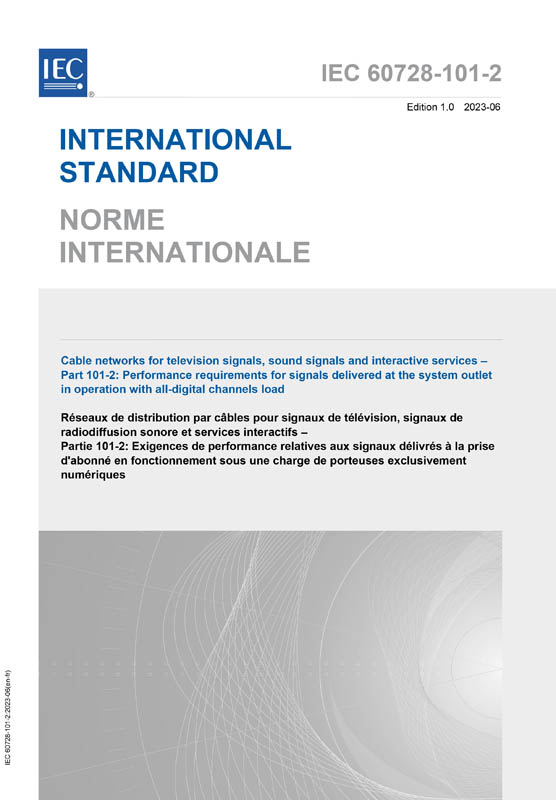IEC 60728-101-2:2023
Cable networks for television signals, sound signals and interactive services - Part 101-2: Performance requirements for signals delivered at the system outlet in operation with all-digital channels load
Ausgabedatum:
2023-06
Edition:
1.0
Sprache: EN-FR - zweisprachig englisch/französisch
Seitenzahl: 60 VDE-Artnr.: 251921
IEC 60728-101-2:2023 provides the minimum performance requirements to be fulfilled in operation at the system outlet or terminal input and describes the summation criteria for the impairments present in the received signals and those produced by the CATV/MATV/SMATV cable network, including individual receiving systems.
In a building divided into apartment blocks, the signals received by the antennas are distributed by the MATV/SMATV cable network up to the home network interface (HNI); the television signals are then distributed (inside the home) by home networks (HN) of various types up to the system outlet or terminal input. The cable network can support two-way operation, from the system outlet (or terminal input) towards the headend.
The home network can use coaxial cables, balanced pair cables, fibre optic cables (glass or plastic) and also wireless links inside a room (or a small number of adjacent rooms) to replace wired cords.
This part of IEC 60728 is limited to downstream TV broadcast signals received from antennas and is applicable to cable networks intended for television signals, sound signals and interactive services operating between about 5 MHz and 3 300 MHz. The frequency range is extended to 6 000 MHz for home distribution techniques that replace wired cords with a wireless two-way communication inside a room (or a small number of adjacent rooms) that uses the 5 GHz to 6 GHz frequency band.
The main sections of a general CATV/MATV/SMATV system, indicating the parts of the IEC 60728-101 series documents where the relevant performance requirements are indicated.
- The requirements for the signals received at the headend are given in IEC 60728-101:2016, Clause 6.
- The requirements for the CATV/MATV/SMATV cable network, assuming an unimpaired input signal at the input of the headend, up to the system outlet are given in IEC 60728-101:2016, Clause 5.
- The requirements for the CATV/MATV/SMATV cable network up to the home network interface (HNI) are given in IEC 60728-101:2016, Clause 7, assuming an unimpaired input signal at the input of the headend.
- The specific requirements from HNI to the system outlet or terminal input are given in IEC 60728-101-1:2023, Clause 5, assuming an unimpaired input signal at the HNI.
- The requirements at the system outlet in operation are given in Clause 6 of this document.
The expression 'in operation' means that the received signals, with their impairments, are applied to the headend input of the CATV/MATV/SMATV cable network. The requirements at the system outlet 'in operation' are derived, therefore, by summing the impairments of the various cascaded parts of the system and of the input signal.
When a change of signal format from digital to digital (e.g. from QPSK to QAM) (e.g. as in ETSI EN 300 473) or from digital to analogue (e.g. from DVB-S/S2 to AM-VSB or DVB-T/T2 to AM-VSB) is made at the headend, the summation of the impairments that produce a relaxation of requirements at system outlet does not apply. Such a case will be the equivalence of unimpaired signals applied at the headend input. Therefore, the requirements at system outlet given in IEC 60728-1 apply.
This document also provides references for the basic methods of measurement of the operational characteristics of the downstream cable network in order to assess its performance.
All requirements refer to the performance limits to be achieved in operation at any system outlet when terminated in a resistance equal to the nominal load impedance of the system, unless otherwise specified. Where system outlets are not used, the above applies to the terminal input.
The present document also provides limits for the accumulation of degradations if the home network is subdivided into a number of parts, using different transmission media (e.g. coaxial cabling, balanced cabling, optical cabling, wireless links).
This International Standard is to be used in conjunction with IEC 60728-101:2016.


